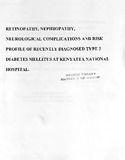| dc.contributor.author | Mwendwa, FM | |
| dc.date.accessioned | 2013-05-24T12:09:28Z | |
| dc.date.available | 2013-05-24T12:09:28Z | |
| dc.date.issued | 2001 | |
| dc.identifier.citation | Master of Medicine (internal Medicine) , University of Nairobi, 2001 | en |
| dc.identifier.uri | http://erepository.uonbi.ac.ke:8080/xmlui/handle/11295/25403 | |
| dc.description.abstract | Background: Type 2 diabetes is an increasingly important health problem in
Kenya. As type 2 diabetes is characterised by a variable period of metabolic
abnormalities prior to clinical diagnosis, microvascular complications may
be present at or soon after the diagnosis of diabetes. The microvascular
complications cause significant morbidity and even mortality yet their
development and progression is largely preventable through modification of
associated modifiable risk factors such as smoking, dyslipidemias,
hypertension and hyperglycaemia. Their most effective management is
therefore through primary and secondary intervention measures. There is no
local data as to the prevalence of these complications and risk factors in the
recently diagnosed type 2 diabetics.
Objectives: The aim of this study was to determine the prevalence of
diabetic retinopathy, polyneuropathy, autonomic neuropathy and
microalbuminuria as a marker of nephropathy in type 2 diabetic patients, and
the prevalence of some associated risk factors within 2 years of the clinical
diagnosis of diabetes.
Materials and methods: This was a cross sectional descriptive study
undertaken in the diabetic outpatient clinic of Kenyatta National Hospital.
Type 2 diabetic patients were recruited and underwent a clinical evaluation
and screening for retinopathy, polyneuropathy, autonomic neuropathy and
nephropathy. Laboratory tests undertaken were fasting blood sugar, glycated
haemoglobin Alc, lipid profile, serum creatinine and a semiquantitative
microalbuminuria assay.
Results: 100 patients were studied. The mean age of the patients was 53.7 +
9.3 years. Family history of diabetes and hypertension was present in 48%
and 24% of the patients respectively. 28% of the patients had a smoking
record although current smokers were 7%. Obesity was frequently seen with
66% classifying as obese and this was preponderant in females (p<0.05).
Hypertension was noted in 50% of which 24% were newly detected, none of
the hypertensives was achieving optimal blood pressure control. Ideal
glycaemic control was being achieved in only 29% of the patients.
Dyslipidemias were also frequently observed. Diabetic polyneuropathy was
present in 28%, autonomic neuropathy in 27%, albuminuria in 26% and
retinopathy in 7%. Over 50% of the patients presented with at least one
complication.
Conclusion: The prevalence of microvascular complications is already quite
high at or soon after diagnosis of type 2 diabetes in our patients. They have
also a high prevalence of associated modifiable risk factors. Prevention
strategies are warranted and justified by the high prevalences at primary,
secondary and tertiary levels. | en |
| dc.language.iso | en | en |
| dc.publisher | University of Nairobi, | en |
| dc.title | Retinopathy, nephropathy, neurological complications and risk profile in recently diagnosed type 2 diabetics at Kenyatta National Hospital | en |
| dc.type | Thesis | en |
| dc.description.department | a
Department of Psychiatry, University of Nairobi, ; bDepartment of Mental Health, School of Medicine,
Moi University, Eldoret, Kenya | |
| local.publisher | Department of Medicine | en |

